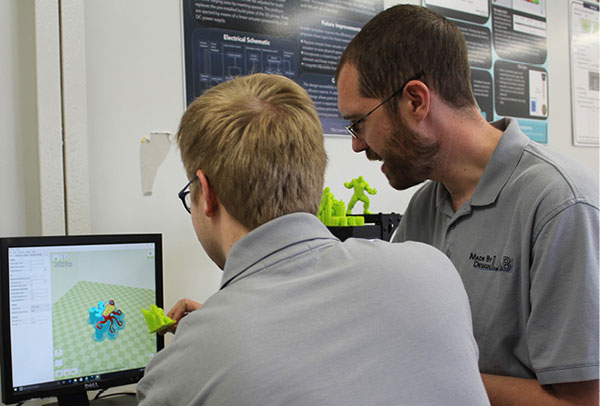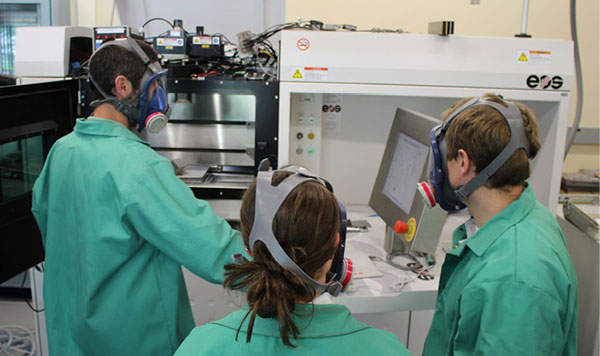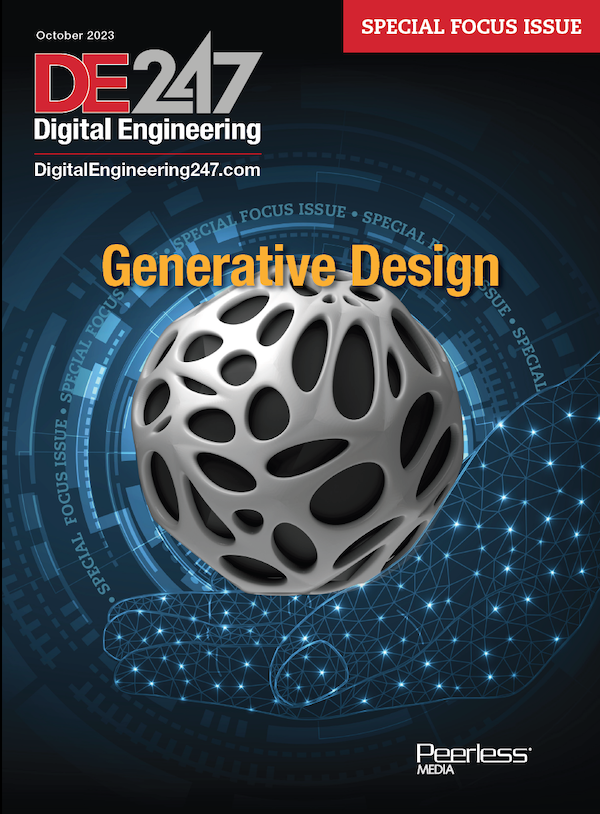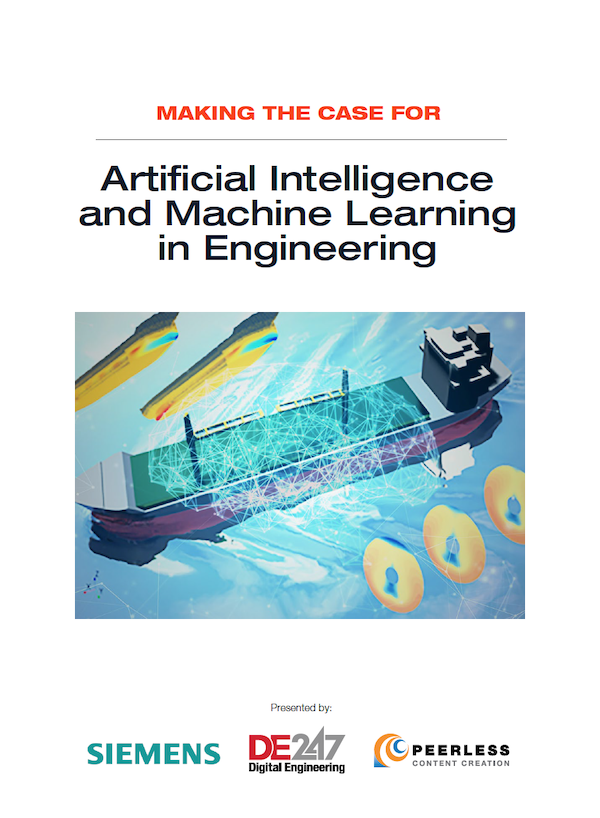Cultivating DfAM Culture
Infusing design for additive manufacturing principles in professional and student engineering settings will help fully exploit AM’s potential.

Professor Meisel, recipient of a National Science Foundation Faculty Early Career Development award, works with Penn State engineering students to transform design thinking. Image courtesy of Penn State University.
Latest News
November 1, 2021
Design for manufacturing (DFM) practices have long been established as critical guardrails to ensure the parts, components and products that engineers dream up can be efficiently and cost-effectively output at scale.
Yet as additive manufacturing (AM) technologies evolve to be better suited for production-grade applications, the traditional DFM playbook is being turned on its head. Instead of adhering to conventional rules about what constitutes manufacturability, organizations need to shift culture and design principles to meet a still emerging design for AM (DfAM) mindset. Without such a transition, organizations will be hard-pressed to reap the full benefits of AM and remain stuck in engineering business as usual.
While the notion of DfAM is similar to DFM—considering manufacturing requirements as part of the early design cycle to overcome limitations or to optimize for the advantages of a particular process—the basic tenets are wholly different, experts say.
With traditional DFM practices, much of the focus is on what can’t be done with manufacturing processes, such as avoiding specific shapes to keep geometry simple or maintaining a particular wall thickness to ensure structural integrity.
In contrast, DfAM champions an approach built around design freedom with a focus on lightweighting, organic shapes and parts consolidation.
“AM takes a lot of what we thought we knew about manufacturing and throws it out the window,” says Nicholas Meisel, assistant professor of engineering design at Penn State.
Meisel also serves as the associate director for workforce education and outreach for Center for Innovative Materials Processing through Direct Digital Deposition (CIMP-3D), PSU’s center for advancing and deploying AM done in partnership with 3D Systems. “With AM, we have to train engineers to unlearn what they think they know about DFM and embrace a counter-intuitive design approach.”
What to Unlearn
Lattices, a key element of DfAM principles, is a great example of how the methodology veers from traditional DFM concepts. Innovating lattice structures is all about recasting a part design not as a solid, but as an more organic bone-like structure to help achieve lightweighting objectives without sacrificing structural integrity. Yet when companies set out with AM for production applications, they typically do an apples-to-apples correlation, meaning they take an existing part and print it directly or do some slight modifications using AM.
The problem with that approach is by leveraging the same design principles and doing a one-to-one conversion, organizations miss the opportunity to leverage AM’s inherent capabilities to improve upon a design.
“You don’t have the freedom to change the design, make it lightweight or minimize overhangs,” says Timothy Simpson, professor of engineering design and manufacturing at Penn State and co-director of CIMP-3D. “Instead, you end up with extra costs and post-processing work—the direct process substitution, where most organizations start, doesn’t yield any real benefits.”

Many engineering organizations are also leery of moving away from tried-and-true design principles they are confident will turn out reliable and high-quality products. With early adopters of AM gearing up to produce high-performance components for aircraft or race cars, it’s natural that they would err on the side of caution when embracing a wholly new DfAM paradigm.
“With AM, you’re being so much more creative with parts, you lean out over your skis when doing so,” Simpson says. “The question is: What is the risk tolerance for pushing designs and what is the organizational climate around failure?”
In fact, decades of institutional knowledge in quality and assurance (QA) practices and materials science for conventional manufacturing methods is another roadblock to the adoption of new DfAM practices and shifting design culture. Companies have poured significant time and money into building up this design intellectual property (IP), which is completely undone once topology optimization or generative design software comes into play to reimagine parts for AM.
“The problem is you completely undo all the QA and assessment you’ve done on legacy parts for a new design paradigm,” Simpson says. “We’re still trying to figure out how to run QA and analytics on much more complex designs.”
As opposed to clinging to legacy processes and design mentalities, engineering organizations need to take more of a systems-level approach to design thinking, says Bradley Rothenberg, CEO of nTopology.
While traditional design and production processes typically optimize designs for separate parts and then fit them together using different tools and through different functions, DfAM practices encourages cross-functional teams to examine the overall process from the start, determining how the overall unit can be improved through use of AM.
“The culture today is how can we make the process more efficient, but the culture should be how do we deliver a better product,” Rothenberg says. “Culture needs to evolve to focus on the results.”
Consider the example of a heat exchanger. A traditional design mentality would employ one team to optimize the design of the external case and another to formulate a high-performance heat exchanger design using simulation. Once both components were optimized, they would come together to result in the final product.
With a DfAM design mentality and culture, the innovation challenge would be to leverage the power of AM to integrate the heat exchanger into the engine case so the engine case becomes the heat exchanger, Rothenberg explains.
“It is both structural and performing the heat exchange operation,” Rothenberg says. “That’s why we need to take a systems-level approach to AM and combine things into one.”
Making all the relevant software tools accessible from a common and familiar platform is one way to simplify the environment and encourage the systems-level design thinking that is central to DfAM, says Jose Coronado, product manager director for PTC.
He says customers are jumping between systems to handle simulation, AM job preparation and slicing, which is impeding their ability to extract value from AM. To streamline the process, PTC is marrying a variety of these core AM capabilities into the Creo CAD design platform.
“Delivering an end-to-end workflow is a great step for people who want to get the most out of AM and see the impact of a design on the final production process and vice versa,” says Nihal Velpanur, product manager for Creo additive manufacturing. “Having a CAD tool that can do all of this [AM work] rather than a fragmented set of tools that do separate functions wrapped together is where the industry is heading.”
Back to School
Adding DfAM curriculum to graduate and undergraduate university programs is crucial to nurturing the next-generation of engineers in AM-optimized design thinking and for helping current-day professionals unlearn some of the legacy design principles.
Penn State is at the forefront of developing DfAM curriculum through the work it does with students and industry at CIMP-3D as well as through its Master of Engineering Additive Manufacturing and Design program, offered in-resident and online, and which to date has matriculated over 200 graduates. The curriculum covers materials science and AM processes with DfAM at its core.
“The design in the course title is intentional because that’s where the value add is at the end of the day,” says Simpson. “Anyone can buy a machine, fill it with powder and hit ‘go,’ but they aren’t designing parts to take advantage of AM and they’re not gaining competitive advantage.”
Penn State takes a two-pronged approach to teaching DfAM principles. It lays out restrictive DfAM concepts that are more in line with traditional design thinking—for example, how to minimize feature sizes, where and how to incorporate support structures and understanding material isotropy to ensure you end up with a viable part off the build platform. Yet it also emphasizes what Meisel calls opportunistic AM, which are the more difficult DfAM concepts to grasp, such as lattice designs, freeform structures, consolidation of parts and customization.
Key to the curriculum are problem-based learning scenarios where students are tasked with a real-world design problem—for example, building a small tower for a scaled-down wind turbine. It’s important to set up these design challenges to incorporate specific constraints and objectives to force students to dive into some of the more opportunistic DfAM concepts, Meisel says.
A team of professors has also devised a deck of playing cards that have become a staple of the AM teaching strategy. Each card in the deck has a DfAM tenet (for example, lattice structures), and students are tasked with developing a design concept based on that particular principle.
Outside of the classroom, there are changes engineering organizations need to make to steer culture toward being DfAM ready. Adopting Agile principles rooted in software development helps engineering organizations encourage more risk taking in design through rapid and iterative prototyping and process improvement.
“Doing this at a process level helps create an understanding of what can and can’t be printed or at a design or feature level, clarify how thin a wall can be made or what a particular internal channel will look like,” Simpson says. “Many times it’s easier to print different variations and test them than wait for simulation results to come back.”
Investing in DfAM training and seeking out champions at middle- or senior-level executive ranks are steps that help infuse DfAM principles into engineering culture. It’s important to train the next generation of engineers with the latest, most advanced tools, but it’s also incumbent on universities and industry to ensure they are realistic about what AM can and can’t do.
Fusing the new engineering mindset with the practicalities and experience of decades-long engineering professionals is the central challenge for organizations steering towards a DfAM future.
“What will help drive change within companies is having bookends for being as creative as possible, but at the same time being realistic,” Simpson says. “Companies that figure out how to bridge that gap and bring those ideas together will be the more successful.”
Subscribe to our FREE magazine, FREE email newsletters or both!
Latest News
About the Author
Beth Stackpole is a contributing editor to Digital Engineering. Send e-mail about this article to [email protected].
Follow DE





